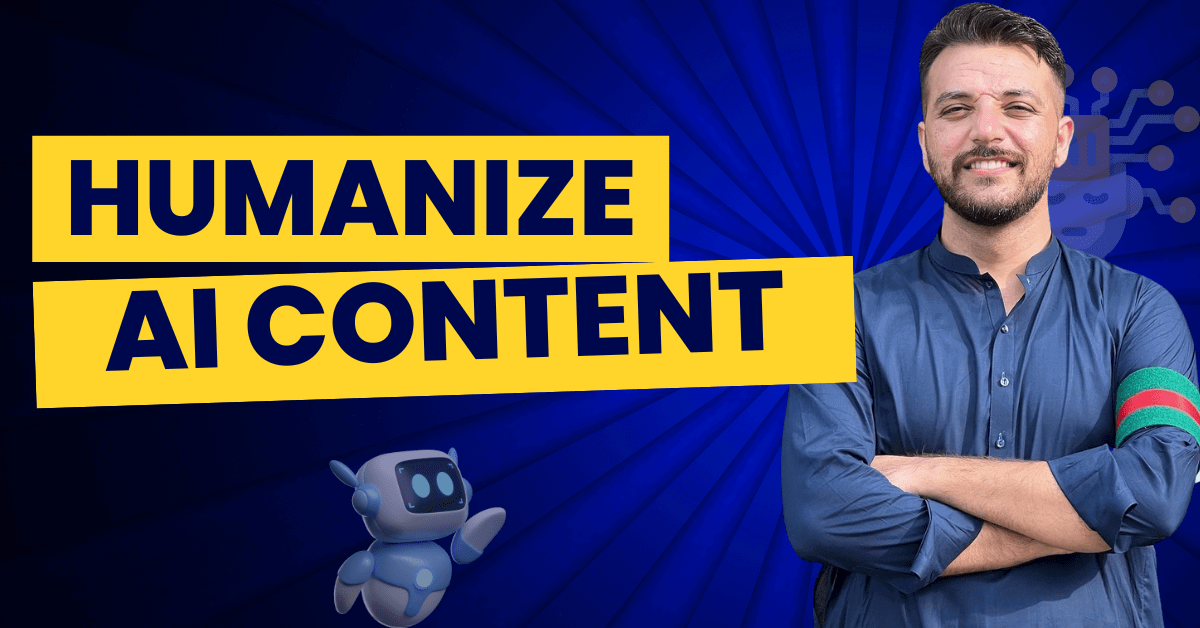I was amazed and skeptical when I started using AI to generate content. The technology could churn out paragraphs in seconds, which takes much longer to compose. However, something was missing. The words were there, but the soul? Not so much. It felt like eating a well-decorated cake that somehow forgot the sugar. You’ve probably felt this, too—reading something that checks all the boxes but doesn’t quite resonate or stir anything within you.
That’s why I decided to dive deeper into humanizing AI writing. It wasn’t just about getting content out faster; it was about retaining the warmth and relatability that only human touch can provide. Think about the last time you read something that made you nod in agreement or smile. Wasn’t it because the writing spoke to you as if understanding your thoughts and emotions? That’s the essence I wanted to capture, and perhaps, too.
In this journey of blending technology with a human touch, I’ve learned quite a bit, and I’m excited to share these insights with you in this blog post. Whether you’re a veteran in content creation or just beginning, grasping the art of personalizing and enlivening AI-generated content can revolutionize your approach. Let’s explore how to give a voice to the voiceless code and turn sterile AI text into engaging, lively content that speaks directly to you and your readers.
Table of Contents
Understanding AI Writing
Before we dive into the heart of humanizing AI content, it’s crucial to grasp what AI writing entails. AI writing isn’t just about letting a robot type away while we sip coffee. It’s a sophisticated blend of algorithms and data patterns that can mimic human writing styles—from crafting blog posts to generating reports. As an ask writer, I’ve come to appreciate the nuances of AI as a tool that can help bridge the gap between rapid content production and maintaining a personal touch. Whether using a speech writer to draft talks or relying on AI for daily content creation, understanding its mechanics is the first step. This foundation improves our use of these tools and guides us in making the AI-generated content sound more human, more ‘us.’

The Rise of AI in Content Creation
The surge in AI’s role in content creation can only be described as a renaissance in the digital world. Just a few years ago, the idea of an algorithm curating articles, social media posts, or even entire books was the stuff of science fiction. Today, it’s our reality. AI has not only entered the content creation arena but has rapidly evolved to become one of the central players. From asking writers who utilize AI to augment their brainstorming process to AI speech writers who craft keynote addresses that capture the essence of a speaker’s voice, the capabilities have expanded exponentially. This leap forward brings a wave of potential and new challenges for creatives and marketers alike. We’re now tasked with harnessing this power while keeping the core of what makes content genuinely engaging—the human element.
How AI Generates Content
The process of how AI generates content is nothing short of fascinating. At its core, AI uses complex algorithms to analyze vast datasets, learning from existing content to replicate a style or tone. Imagine a sponge that can soak up the entirety of the written word and then squeeze out new creations that echo the familiar cadence of human writing. It’s a symphony of data points and linguistic patterns playing in harmony to produce content that ranges from simple blog posts to intricate reports. However, it’s not magic—it’s science. As these AI programs sift through the text, they learn how to predict what word should naturally follow another, crafting sentences that often only the keenest eye could distinguish from those written by a human. And yet, here I stand, on the threshold between man and machine, ready to guide AI with a human touch to ensure that while the content is machine-made, it retains the warmth of human creativity.
The Importance of Human Touch in AI Writing
In the world of AI writing, the human touch is what turns strings of text into stories that resonate. It’s the difference between a meal prepared with precision by a machine and one crafted with the love of a seasoned chef. AI can assemble words, follow grammatical rules, and even mimic styles, but it doesn’t feel joy, sorrow, or passion. That’s where we come in. Injecting our unique perspective and emotional depth transforms AI-generated drafts into pieces with heart and soul. It’s not just about correcting errors or tweaking sentences; it’s about breathing life into the text. This human touch ensures that our content does more than inform—connects, inspires, and engages. So, as we look at ways to enhance AI writing, let’s remember that our humanity is the irreplaceable ingredient that gives flavor to the feast of words.
Benefits of Humanizing AI Content
Humanizing AI writing is not just a nicety; it’s a necessity. It’s the seasoning that takes the content from bland to brilliant. We transform AI-generated text into something with a heartbeat by transforming AI-generated text into something with a heartbeat. This human touch can mean the difference between a reader bouncing after a few lines and one who stays, engages, and converts. Humanized content is more likely to evoke an emotional response, build trust, and foster a real connection with the audience. For me, it’s about striking a balance between efficiency and authenticity. Whenever I infuse a piece with personal anecdotes or tailor it to the reader’s emotions, the content becomes a bridge between my world and theirs. That’s the true power of humanizing AI writing—it turns readers into listeners, engages them in a conversation, and sometimes into lifelong customers.

Strategies to Infuse Humanity into AI Writing
As we delve into the realm of AI writing, the quest to retain the human essence within the digital ink becomes paramount. It’s a dance between the algorithmic precision of AI and the nuanced flair of human creativity. Over time, I’ve honed strategies to seamlessly blend the two, ensuring that every piece of content, while technically AI-produced, feels as though it has been carefully crafted by a human hand. These strategies are not just about adding a personal touch—they’re about stitching together the fabric of human experience with the threads of technology. It’s a collaborative process where I guide the AI, teaching it to echo our human conversations’ empathy, humor, and idiquirksat. By sharing these methods, I aim to equip you with the tools to make your AI writing indistinguishable from content written by the most passionate educators.
A crucial step in making AI writing more human is to infuse it with your unique vocal tone, adding to the digital symphony. I’ve discovered that when I let my personality shine through the text, the AI’s output morphs from something formulaic to a piece with my fingerprints all over it. This isn’t about dominating the technology; it’s about forming a collaborative bond where my stories, tone, and distinctive traits steer the AI toward crafting content that resonates and forms a genuine connection with you. Every anecdote shared, every joke woven in, every heartfelt confession makes the reader pause and think, “This speaks to me.” That’s the goal—to turn the monologue of AI writing into a dialogue that feels as natural as a chat with an old friend.
Emphasize Storytelling and Anecdotes
The magic of storytelling and anecdotes is their power to transform any narrative, making it infinitely more engaging and memorable. I remember sitting down with a dry, AI-generated article about data analytics and thinking, “How can I make this come alive?” The answer lay in the power of slides. By sprinkling in personal anecdotes—like the time I almost drowned in data before a crucial presentation—I was able to weave a narrative that not only delivered the facts but also a journey. This approach turns readers into active participants, allowing them to see their reflections. It’s about transforming the act of presentation into creating an experience, transitioning from simply offering data to crafting a vivid tapestry filled with emotion, color, and texture. Thassence of effective communication—it’s not just about what you say; it’s about making others feel and remember.
Technical Tips for Humanizing AI
In our quest to bring humanity to AI writing, we often overlook the technical scaffolding that can elevate our content. Humanizing AI writing isn’t solely about infusing emotional intelligence; it’s also about thoughtful, technical adjustments that can make a world of different intelligence. Think of it as teaching orchestras to play with the heart of a human musician. Through careful tuning and attention to detail, the music produced can stir the soul. This translates to tweaking syntax and adjusting the content to fit the reader’s intent in the digital world. It’s a meticulous process, but when done right, it enables the A in the digital world to serve not just as a writer but as a storyteller—a bearer of messages that resonate with a profoundly human note. Let’s delve into these profound nuances and uncover how we can leverage them to turn our AI writing into something that feels crafted by hand, not calculated by circuits.
Adjusting Tone and Style
Adjusting the tone and style is like choosing the right outfit for the occasion—it can completely change the impression you make. When I began experimenting with AI writing, the content felt like it was donned in a tuxedo for a casual brunch—it simply didn’t fit. I could dress my words appropriately by tweaking the tone to match my voice and the style to suit the subject. The key is to recognize that just like a keyword can signal the focus of your content, the tone and style are the subtler, emotional keywords that signal your readers what they can expect from your writing. Whether adopting a friendly tone for a welcome email or a professional style for a white paper, these adjustments are crucial in humanizing AI writing, making each piece of content read, felt, and remembered.

Enhancing Readability and Engagement
Enhancing readability and engagement in AI writing is akin to hosting a dinner party. You want to lay everything on the table to invite conversation and make guests want to stay longer. Similarly, when I craft content, I focus on breaking down complex ideas into bite-sized, digestible pieces that beckon the reader to indulge further. It’s not just about short sentences and clear language; it’s about creating a rhythm that matches the ebb and flow of human thought. Engaging content invites the reader in, offers them a seat, and engages them with a compelling story or a thought-provoking question. It’s about making every line count, every word pull its weight, ensuring that from the headline to the final call to action, the reader is on a journey they are eager to continue.
Using Varied Sentence Structures
The beauty of varied sentence structures is like the rhythm in music; it can transform a monotone into a melody that captures the audience. Playing with sentence length and structure creates a dynamic flow that keeps the reader engaged when I write. Beginning a sentence with a dependent clause or incorporating a succinct, one-word question can spark curiosity. Long, descriptive sentences can be followed by short, impactful statements, much like taking a long breath before a plunge. It’s this variety that keeps the eyes moving and the mind active, turning the act of reading into an experience rather than a task.
Implementing Conversational Elements
Implementing conversational elements is the secret ingredient to make content relatable. It’s the difference between talking to someone and chatting with them. When I sprinkle in questions or break the fourth wall by addressing the reader directly, it invites them to participate. “Have you ever noticed this?” or “Imagine that” are not just words; they’re invitations to dialogue, think, agree, or counter. This technique breaks down the barriers between the writer and the reader, creating a bond that holds through the pixels and screens.
Leveraging Emotional Appeals
Leveraging emotional appeals means reaching out through the text and touching the reader’s heart. Whenever I write, I think about the feelings I want to evoke. Is it the warmth from a story about perseverance, the stirrings of inspiration from an underdog tale, or the comfort of knowing you’re not alone in a challenge? By intentionally choosing words and scenarios that resonate emotionally, I turn mere sentences into messages that can move, motivate, and connect on a deeper level.
Advanced Editing Techniques
Venturing into advanced editing techniques can be likened to delving into a master craftsman’s toolbox, where every instrument is designed to transform and perfect the unrefined substance into a masterpiece. Applying these editing techniques to AI writing becomes an intricate dance of honing and shaping. It’s not just about spell check or grammar correction; it’s a deliberate process of refining and enhancing the text to resonate with human sensibilities. Techniques like varying sentence rhythm, employing strategic repetition for emphasis, or using metaphors to illuminate concepts transform the output from mechanically correct to compellingly crafted. Every edit is a step towards a narrative that feels less like it was written by an algorithm and more like a thoughtful human writer penned it. With each choice and tweak, I aim to bridge the gap between technology’s cold precision and human expression’s warm complexity.

Iterative Editing for Natural Flow
Iterative editing is writing what refinement is to gold—each pass brings a new shine and clarity. I approach editing not as a one-time fix but as a layered process. With each read-through, I uncover new opportunities to smooth transitions or enhance the narrative’s rhythm, ensuring the natural flow of language that echoes human thought. This method allows me to gradually shape AI-generated content into an organic form, where each sentence cascades into the next. It’s a sculpting of words and ideas, removing the rough edges until what remains is a seamless piece that reads as if it were spoken aloud. The content begins to breathe through this meticulous process, and that’s when you know it’s ready to be shared with the world.
Reducing Repetitiveness and Jargon
Reducing repetitiveness and cutting through jargon has been paramount in my journey to polish AI-generated content. It’s like clearing away weeds in a garden so the flowers can flourish; removing redundant phrases and industry-specific lingo makes the message more precise and accessible. I carefully comb through each paragraph, replacing repeated words with synonyms and translating technical terms into everyday language. This ensures that the writing is more enjoyable and reaches a broader audience. After all, the goal is to communicate, not to confuse. By stripping away the excess, what’s left is crisp, clean prose that invites readers in, regardless of their background. This method promotes inclusiveness and guarantees that the content’s core message is delivered straightforwardly, without undue intricacy.
Moving Forward with AI Writing
As we look to the horizon, AI writing isn’t just a fleeting trend; it’s a staple in the evolving landscape of content creation. Embracing it is no longer optional—it’s imperative for staying relevant and competitive. As I navigate this ever-changing territory, I recognize that moving forward with AI writing means continuous learning and adaptation. It’s about anticipating the needs of tomorrow while grounding yourself in the human-centric skills that AI can’t replicate. Let’s explore where AI writing is headed and how we can evolve alongside it to maintain the personal touch that defines excellent content.
Future Trends in AI Writing
The future of AI writing is teeming with possibilities. We’re on the cusp of AI that doesn’t just mimic human writing but adapts to individual styles and tones with unprecedented accuracy. I envision a landscape where AI assists in creative brainstorming, suggests narrative arcs, and even helps us overcome writer’s block. It’s an exciting prospect, hinting at a future where the line between human and machine creativity becomes increasingly blurred, opening up a world of efficiency and innovation for writers everywhere.
How to Stay Ahead in AI Humanization
Staying ahead in AI humanization is akin to surfing—the best surfers anticipate the wave’s movements and adjust their stance accordingly. For writers, this means being proactive in our approach to AI writing tools. It involves not just using AI but shaping it: feeding it examples of our best work, training it on the nuances of emotive language, and never settling for the first draft. It’s a commitment to being at the forefront of this new wave, ensuring that the human essence in our content remains unmistakable and irreplaceable as AI grows more sophisticated.
Conclusion
We must pause and reflect as we journey through the labyrinth of AI writing’s future. Picture yourself a few years later, your fingertips skimming over a keyboard, the AI poised to assist you. You’re no longer wrestling with writer’s block or tedious drafts; instead, you’re directing an AI that understands the ebb and flow of your creative tides. It’s not just about the efficiency of producing content but the joy and authenticity it holds. Will you be riding the crest of this wave or watching from the shore? The answer lies in how we engage with AI today. Let’s be the architects of this new era, crafting tools and narratives that bear the indelible mark of our humanity. This isn’t about replacing ourselves; it’s about augmenting our capabilities and reaching new heights of creativity. Think about it: where do you see yourself in this picture, and more importantly, how will you shape it?
Frequently Asked Questions
FAQ 1: Can AI writing match the quality of human content?
Answer: AI writing can come very close to human quality with the right techniques. It involves humanizing the AI’s output by personalizing the content, using storytelling, fine-tuning the tone, and applying advanced editing methods. This collaborative process ensures the content is informative and resonates on a human level.
FAQ 2: How can I add a personal touch to AI-generated content?
Answer: Personalizing AI content can be achieved by incorporating your unique voice, sharing your experiences, and writing as if speaking directly to the reader. Using conversational language and emotional appeals also helps make the content more personal and engaging.
FAQ 3: Won’t using AI for writing make my content sound robotic?
Answer: Not necessarily. While AI can start with a neutral tone, employing strategies like iterative editing and reducing jargon can help create a natural flow that feels more human. It’s about guiding the AI to adopt a style that’s uniquely yours, making the content sound far from robotic.
FAQ 4: How do I keep up with the changes in AI writing technology?
Answer: To stay abreast of AI writing technology, one must keep a pulse on emerging trends, actively test new tools, and consistently refine editing strategies for AI-generated content. Embrace the technology, learn from it, and don’t be afraid to blend your human creativity with AI’s capabilities.





